50 Asset Inventory Management Tips and Best Practices
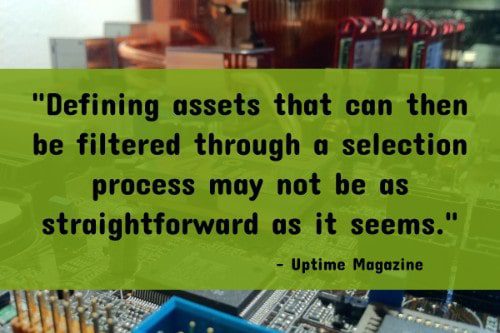

If you have any experience managing inventory, then you know just how important it is to consider each and every item as an asset, for both the health and livelihood of your operation, whether your a Fortune 500 or a small business. And it’s not just the SKUs filling up your warehouse, but the valuable equipment, devices, and other assets you rely on for day-to-day operations that must be effectively tracked and managed.
It may seem like a fundamental concept that all businesses follow, but when you consider that a whopping 46% of SMBs either rely solely on manual asset management – or don’t track inventory at all – it’s easy to see why asset inventory management is a persistent hot button issue for companies spanning many industries.
Fortunately, there are plenty of tried and true resources available that can help even the most ‘bare bones’ of operations transition into the world of asset inventory management efficiently and with little upfront investment. We’ve weeded through advice from the authorities on the subject so that we could bring to you the 50 top inventory asset tips and best practices offered up today.
Below, you’ll find quotes straight from these expert resources, conveniently organized by category.

1. Take the time to define any and all assets. “Defining assets that can then be filtered through a selection process may not be as straightforward as it seems. From an expanded view of asset management, there are different levels at which an asset can be managed. At a foundational level assets are viewed individually. This is the simplest and most easily understood approach.
“Assets can also be defined and viewed in terms of systems. Examples of asset systems can include networks, production lines or facilities systems (HVAC, waste water, compressed air). And finally a third expanded view can define asset portfolios. Examples include classes of oil rigs, business units, real estate, and municipal infrastructure.” – Developing Asset Management Plans, Uptime Magazine via Life Cycle Engineering; Twitter: @uptime
2. Rethink and/or establish your processing and fulfillment practices. “Number of orders is the most important factor for a business because it represents revenue. But many companies do not have proper systems to handle, process and fulfill these orders. The best thing to do is create a list of tasks that need to be completed to fully process and fulfill an order.” – Raad Mobrem, 6 Tips for Inventory Management, SmallBiz Resources; Twitter: @Small_BizHelp
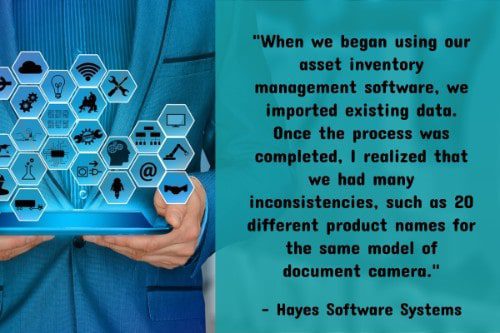
3. Before implementing software, ensure that you are starting with clean data. “When we began using our asset inventory management software, we imported existing data. Once the process was completed, I realized that we had many inconsistencies, such as 20 different product names for the same model of document camera. If we had taken the time to sort through our data and clean it up, we would have caught those discrepancies. It would have saved us a lot of headaches because now we are having to go back through all of this data and clean it up so that our inventory reports are consistent and accurate.” – 5 Tips for Creating a Successful Asset Inventory Management Program at Your District, Hayes Software Systems; Twitter: @HayesSoftware
4. Apply cost-effective management techniques. “Are you managing your assets in a proactive or reactive manner? In most cases, proactive management is more cost-effective in the long-run than reactive management. For example, if you wait until there is a bad pothole on one of your streets before performing road maintenance, you can end up spending more money than if you proactively conduct road maintenance over time. You’re practicing cost-effective management when you do the most cost-effective maintenance, repair or replacement at the right time during the entire asset life-cycle.” – 5 Steps to Building an Effective Asset Management Plan and Asset Planning, Asset Works; Twitter: @AssetWorks
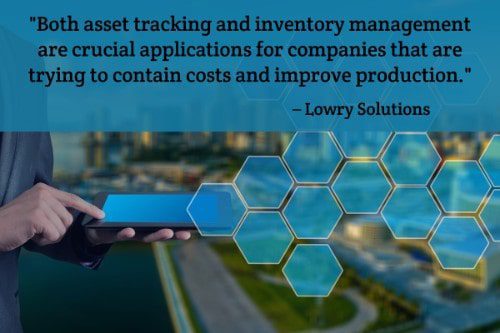
5. Don’t underestimate the importance of asset and inventory intersection. “Assets and inventory do occasionally cross over within the same enterprise. Some companies use asset management solutions to track and manage equipment (like servers, oil pumps, or heavy machinery) for service and maintenance that they have already delivered to customers. In this case, an end use item that was tracked using an inventory management solution during production and sales is now being tracked with an asset management solution.
“Both asset tracking and inventory management are crucial applications for companies that are trying to contain costs and improve production. Knowing the difference between these operations and the systems that can improve them will help enterprises better address and manage their unique challenges.” – What is the Difference Between Inventory Management and Asset Tracking, Lowry Solutions; Twitter: @lowrysolutions
6. Set safety lock levels–and re-evaluate as business changes. “Inventory stock management is made easier by downloading inventory software. You can set safety stock levels for each of your products. These are inherently the minimum amount of inventory stock that you need on hand at all times, to never miss out on a sale. When your inventory stock falls or gets close to these safety levels you will be alerted to order more. It is important that this is revised, especially with seasonal products. You will need to adjust their safety stock levels so you do not have too much inventory stock on hand especially in markets that are prone to market fluctuations.” – 4 Best Practices for Inventory Stock Management, Unleashed; Twitter: @unleashedteam
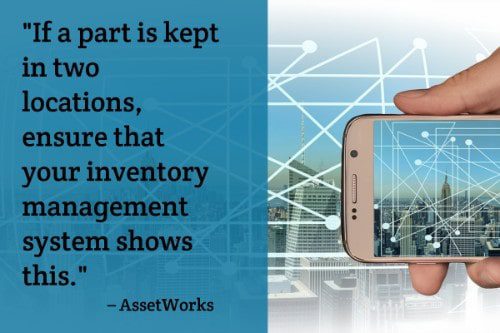
7. Create – and verify – your strategic locations. “Before your inventory day, verify that all of the parts in your inventory have a location listed in your inventory management system. You should also ensure that these locations are correct.
“If a part is kept in two locations, ensure that your inventory management system shows this. This step ensures inventory counters won’t run around trying to find a part or, even worse, marking an incorrect count because they cannot locate the part. Checking bin locations during cycle counts makes this task easier at the end of the year.” – Tips for Successful Annual Physical Inventory, AssetWorks; Twitter: @assetworks
8. Good asset inventory management practices will save you money. “When you have a solid inventory system you’ll know exactly how much product you have, and based on sales you can project when you’ll run out and make sure you replace it on time. Not only does this help ensure you don’t lose sales (critical for cash flow), but it also lets you plan ahead for buying more so you can ensure you have enough cash set aside.” – Cassandra Campbell, Warning: You’re Losing Money by Not Using These 8 Inventory Management Techniques, Shopify Blogs; Twitter: @shopify
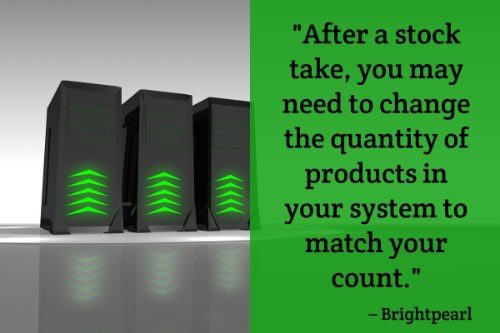
9. Get prepared to record your stock corrections. “After a stock take, you may need to change the quantity of products in your system to match your count. The best way to do this is with a stock correction, following these tips:
10. Establish a loss prevention plan that’s tailor-made for your operation. “Behind every inventory loss prevention or reduction success story identified by the Group lies good loss data. Timely, accurate, and actionable data available to all the right stakeholders, broken down by item and by store, leads to improved collaboration, more of the right actions, and enables the ongoing tracking of results and performance trends. Today, the only way to get this data is through regular cycle counting in-store. Tomorrow, the hope is that smart-shelf technology, including radio-frequency identification (RFID) will provide this visibility faster, at a much lower cost, and with a greater degree of accuracy.” – Colin Peacock, 15 Best Practices for Inventory Loss Prevention, LPM Insider; Twitter: @lpmag

11. Make decisions that maximize your ROI. “Asset management aids businesses in maximizing the return on every investment. When you rely on asset management to inform purchase decisions and stay on top of ongoing maintenance, you’ll get more life out of your expensive assets.
“Additionally, by improving asset utilization across the workforce, workflows become more efficient and production increases. The elimination or reduction of waste from lost or stolen assets is also reduced. Finally, asset management enables the efficient scheduling of shared assets across teams and departments, reducing the need to purchase duplicate assets unnecessarily.” – 4 Goals for Asset Management, Camcode; Twitter: @camcode
12. Invest in and implement Big Data technology. “Tools such as handheld scanners and RFID tags can help you identify and correct inaccuracies quickly. Information, after all, is vital for any successful asset management program. Before choosing software or equipment, you must develop and implement equipment monitoring and evaluation procedures. Once you’ve implemented a new asset management system, it’s necessary to continually evaluate and monitor the chosen software system to ensure that it’s working properly and conforming with established management procedures. This includes developing mechanisms for identifying and correcting data inaccuracies.” – Ryan Ayers, Asset Management for Your Construction Firm, Business.com; Twitter: @businessdotcom
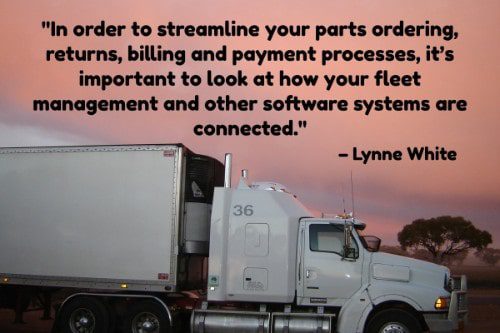
13. Integrate any and all management systems. “In order to streamline your parts ordering, returns, billing and payment processes, it’s important to look at how your fleet management and other software systems are connected. Integration also ensures data accuracy and reduces demands on administrative, finance and other personnel, in some cases even cutting staffing needs.” – Lynne White, Having the Right Parts on Hand When Needed is Critical for Any Successful Workshop, Chevin; Twitter: @chevintweet
14. Find ways to automate your asset inventory. “Some network management software solutions can discover, map network assets and create inventories that automatically update to reflect changes in device configuration and status, and present the information to the administrator through well-organized views and comprehensive reports.
“What’s important is that the tools work across a variety of technologies and protocols—ARP, SNMP, SSH, Virtual Infrastructure Management, IP addressing, ICMP, LLDP, WMI and Telnet—to automatically discover, locate and collect comprehensive device information across routers, printers, switches, servers and firewalls.” – Best Practices Asset Inventory, WhatsUp Gold
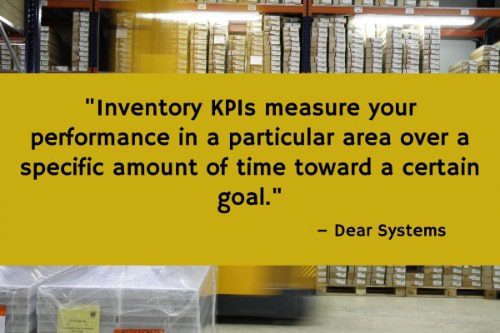
15. Establish iron-clad inventory KPIs. “Inventory KPIs measure your performance in a particular area over a specific amount of time toward a certain goal. They help to eliminate guesswork by giving you clear milestones to hit every week, quarter, or year. With them, you’ll have the data you need to make smart, strategic decisions for your business.” – 10 Inventory Management Best Practices for Improving Your Business, Dear Systems; Twitter: @DearInventory
16. Adopt specialized security measures for your parts department.“Ensure that effective security measures are taken in the parts warehouse. Several critical practices should be considered. Limiting access to the parts warehouse inventory is crucial to maintaining inventory accuracy. Adopt a policy that parts inventories are ‘off limits’ and only parts department employees have access.
“The first way to ensure this is to adopt physical security measures such as parts counters that prevent employees from entering inventory stock locations and pulling parts required. Allowing everyone to have access can quickly make parts inventories inaccurate. The second practice to help assist in this objective is to install security camera systems and begin utilizing badge access to entry and exit points.” – Brian Barry, 7 Spare Parts Inventory Management Best Practices, F. Curtis Barry & Company; Twitter: @FCurtisBarryCo
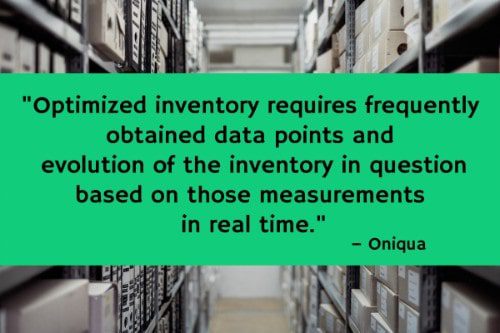
17. Develop an inventory support system that’s made for your situation. “Optimized inventory requires frequently obtained data points and
evolution of the inventory in question based on those measurements
in real time. A decision support system that incorporates best practice
methodologies gives inventory managers a powerful tool to manage their
business objectives and make their teams significantly more effective.” – 12 Best Practices of Inventory Optimization, Oniqua; Twitter: @oniquaanalytics
18. Develop a storage plan that pairs well to your specific warehouse. “One typically thinks of warehouses as those places where goods and commodities are kept until they are distributed. Warehouses are in fact complex real property assets requiring access (such as rail, water and roads), security, IT technology, temperature controls, and life-cycle and
supply chain management. These factors influence how agencies assess and analyze the warehouse as a real property asset for current and future mission and program requirements. Reduction strategies for warehouses must take into account the functions supported by the materials stored in the warehouses, the supply chain needed to make the most efficient use of
the warehouse, real time business intelligence, and the technology advances that require fewer resources to support the mission.” – White Paper on Warehouse Management Best Practices, General Services Administration Office of Government-wide Policy; Twitter: @USGSA

19. Prioritize your demand action planning. “Being able to pre-empt and predict demand allows for the maximizing of cost savings. With regards to inventory management, it allows your business to establish the minimum and maximum inventory levels. Inventory that is idle is costly because of the expenses incurred handling and monitoring, as well as the additional storage costs.” – What is Inventory Management and Control?, Amcap; Twitter: @amcapaus
20. Only invest in technology that provides real-time analysis. “Once you have up-to-the-minute information on inventory levels and fulfillment status, you need to be able to continuously analyze your supply chain to
ensure profitable demand fulfillment. Will insufficient stock levels result in service-level fines or lost sales? Will overstocks lead to increases in obsolete
inventory? Bottom line: What is the most profitable response to a given stock situation? Giving planners real-time visibility supported by sophisticated analytics that draw simultaneously from all of your available
data on the net.” – 4 Best Practices for Agile Inventory Management, Infor; Twitter: @infor
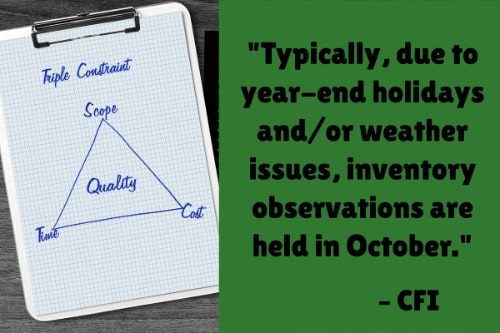
21. Develop a smart and consistent auditing plan for the least expected scenarios. “Other issues that may arise and be of concern to an auditor include the timing of the inventory observation. The observations usually take place at the end of October or the end of December. Typically, due to year-end holidays and/or weather issues, inventory observations are held in October. However, if the client is more prone to fraud/manipulation and is notorious for that, auditors may show up at the end of December to obtain more reliable data.
“Another issue is whether the auditor needs to bring in a specialist or run some off-site testing to make sure that the inventory in the warehouse is genuine. For example, for some goods such as jewelry, grain, or other high-tech products, it is uncommon for the regular auditor to differentiate between real and fake goods. Auditors may want to bring in a specialist for a thorough examination or send some samples to a lab for proper testing.” – What is an Inventory Audit?, CFI; Twitter: @InnovationCA
22. Devise an airtight policies and procedures manual that’s made for your business’ fixed assets. “Policies and procedures should be established to ensure consistent and correct accounting for and management of fixed assets. Such policies need to cover all possible aspects of fixed assets. Consider areas such as: capitalization threshold; accounting treatments; approval process of acquisitions, transfers, and disposals; useful/depreciation lives; asset construction; debt cost capitalization (US GAAP); periodic fixed asset inventories; and so on.” – Fixed Asset Best Practices, Simplestudies; Twitter: @simplestudies
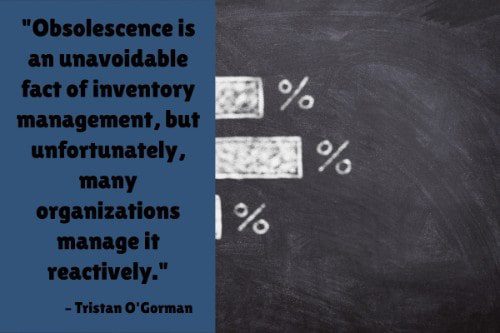
23. Prepare for the worst. “Obsolescence is an unavoidable fact of inventory management, but unfortunately, many organizations manage it reactively. To manage obsolescence proactively, organizations must be able to answer questions such as the following: How can we anticipate obsolescence? What contingency plans have we in place? What are our most important needs? Should we maintain items, or replace them? How do we ensure safety?
“Such organizations should develop an obsolescence risk assessment process, helping inventory managers assess the probability that items will become obsolete and flag the items that are at greatest risk of becoming so. To augment the process, inventory managers can use analytics to identify already obsolete items, identify items that the organization can afford to manage reactively and reduce the manual effort involved in computing the probability of obsolescence. Incorporating analytics into the obsolescence process gives organizations the data they need to apply mitigation strategies such as supplier agreements, systems upgrades or risk mitigation purchases.” – Tristan O’Gorman, 5 Inventory Analytics Best Practices to Achieve Inventory Optimization, IBM Big Data and Analytics Hub; Twitter: @IBMAnalytics
24. Share your management strategy across all departments. “Creating the strategy to change employees’ behavior starts several months before any changes are implemented on the storeroom floor. To establish the scope of the project, you need to define what the changes are going to look like and create the vision of benefits that will result from the project.
“It’s always a good idea to get a new set of eyes to look at a current situation and ask why we do things this way. To assess the barriers and issues facing the storeroom employees, select a team of employees that represent a cross-section of the organization. The team should consist of a team leader, sponsor, and four to five team members. Members of this team should be employees that are viewed as leaders in the organization and that are comfortable brainstorming for new ideas to provide solutions to current storeroom practices that are causing waste.” – Wally Wilson, Changing the Storeroom Culture to Best Practice Performance, Life Cycle Engineering; Twitter: @LCE_Today
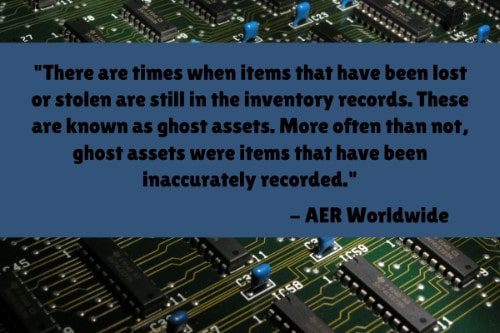
25. Be aware of all ghost assets. “Remove ghost assets in your inventory. There are times when items that have been lost or stolen are still in the inventory records. These are known as ghost assets. More often than not, ghost assets were items that have been inaccurately recorded.” – Top Ten Reasons Why Asset Management is Important, AER Worldwide; Twitter: @AERWorldwide
26. Establish specialized reordering parameters. “The reordering parameters — minimum and maximum levels (MIN/MAX) — used by the ERP materials management system to generate replenishment orders are the main determinants of inventory outcomes. Reordering parameters should be optimized periodically to reflect changes. The optimization process addresses:
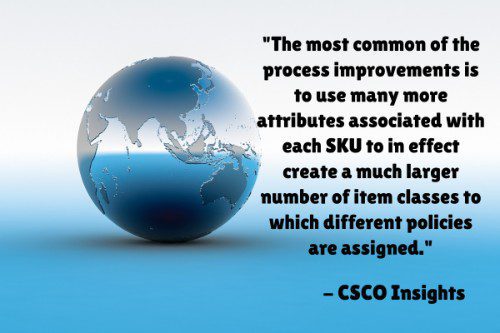
27. Diversify your SKU attributes. “The most common of the process improvements is to use many more attributes associated with each SKU to in effect create a much larger number of item classes to which different policies are assigned – well beyond the standard three or four levels most companies still use. These attributes can include lead times, supply and demand variability, consumption patterns, criticality, velocity, and several others. The more dimensions a company uses, the greater the precision a company will have in managing inventories. It is not uncommon to see 10-12 dimensions being used in best-in-class companies.” – Five Strategies for Improving Inventory Management Across Complex Supply Chain Networks, CSCO Insights; Twitter: @cisco
28. Invest in asset inventory training sessions. “Having good, competent staff can make all the difference to a company’s success. Inventory management training equips your employees with the latest ideas and best practice methods of inventory control. Providing your employees with inventory management training is essential if the objectives of an organization are to be suitably met.
“By investing in inventory training, you can ensure that your employees are being given the necessary tools to do their jobs effectively. Training helps staff to improve their knowledge, skills and capabilities, enhancing their overall efficiency and reducing inventory waste. This in turn will lead to greater quality performance.” – The Importance of Inventory Management Training for Your Staff, Unleashed; Twitter: @unleashedteam
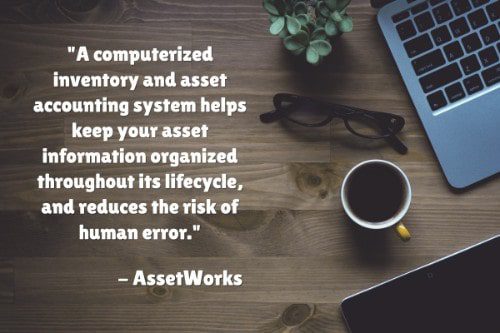
29. To promote accuracy, provide your workers with adequate systems training. “A computerized inventory and asset accounting system helps keep your asset information organized throughout its lifecycle, and reduces the risk of human error. If used regularly during your annual inventory process, a good solution can help to ensure that all data is accurate and up to date. So the next time you’re trying to view the details of an asset, like its serial number or financial information, you can rest assured that the information in your database is correct.
“Maintaining accurate data within your asset management system throughout the year means that you’re more likely to end up with financial reports you can rely on. This information is critical for compliance, and helps to support informed decision making during the budgeting and planning processes.” – Automating Asset Tracking & Inventory Processes | 5 Benefits, AssetWorks; Twitter: @assetworks
30. Focus on building your leadership skills. “Inventory managers need to be effective leaders. They hire and fire and manage a team of employees, and all the challenges that entails. They need to lead their team. They also need to be able to take direction and work as part of a bigger team. Most inventory managers will need to work with marketing and sales departments as well as purchasing managers to organize the efficient flow of inventory in and out of the company.” – Jay Schofield, 6 Things Great Inventory Managers Do, System ID; Twitter: @System ID
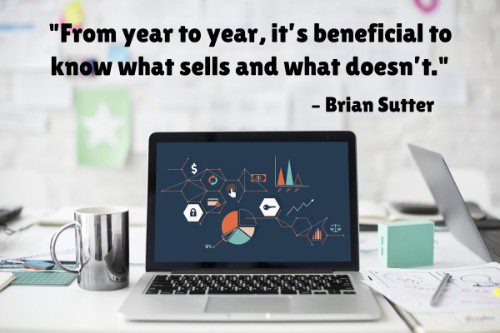
31. Prioritize product tracking awareness. “From year to year, it’s beneficial to know what sells and what doesn’t. This information helps you plan and make more informed business decisions for the future. You’ll avoid losses due to products sitting on shelves for too long or losing sales because products sell out too quickly for customer demand.” – Brian Sutter, Director of Marketing, Wasp Barcode Technologies, Inventory vs Asset Management: What’s the Difference?, Score; Twitter: @SCOREMentors
32. Take advantage of your inventory management system’s onboarding/training solutions. “Many inventory management solution providers in today’s market offer training or onboarding services so both you and your employees can learn how to take full advantage of the system’s features and capabilities. The team behind the service itself will be able to give you the most comprehensive overview of the system, and they’ll be able to provide support and further assistance in any necessary areas.” – Nikki Michaels, 5 Tips to Help Retail Employees Stay on Top of Inventory, Vend; Twitter: @vendhq
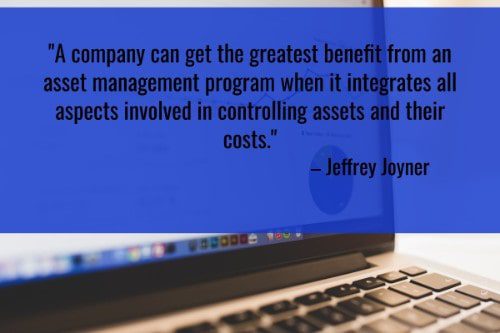
33. Take a systemic approach to inventory asset management. “A company can get the greatest benefit from an asset management program when it integrates all aspects involved in controlling assets and their costs. The program should cross all lines between departments and disciplines to focus on the total value. Managers should use a systematic approach, applying standards in a structured way.
“Risks must be evaluated and, if necessary, compromises found that best balance risk against performance and cost. The program should allow managers to examine assets in context of their use and value to the company. A good asset management program will also be sustainable, helping to optimize the life of assets while considering long-term effects such as environmental impact.” – Jeffrey Joyner, What is the Purpose of an Asset Management Program?, Chron; Twitter: houstonchron
34. Provide sufficient training – and schedule appropriately. “By studying your work order history and your maintenance schedule, you can usually accurately predict how much staff and how many man-hours you can anticipate needing during the year. With this number in mind, you can then schedule your employees appropriately and not just have workers standing around twiddling their thumbs. Or maybe you will find that your problem isn’t over-staffing but under-staffing instead. Missing a routine maintenance here or there happens – but when you begin missing them frequently due to not having enough staff, things can go south very quickly.” – Lisa Richards, 7 Benefits of Inventory Management, Mapcon; Twitter: @MAPCONtech
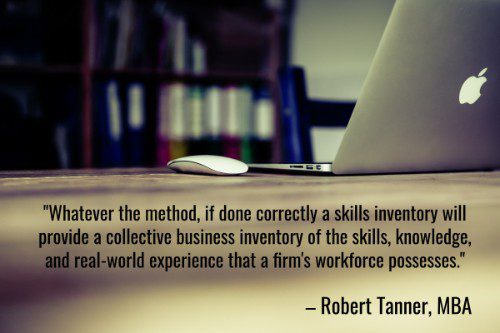
35. Once you have implemented an asset inventory training program, get the most out of it by shoring up your skills inventory. “A skills inventory summarizes the skills, education, and experiences of current employees. Depending on the size and complexity of a business, the process for preparing a skills inventory will vary. Some businesses use commercial software. Other firms use database programs. Some small businesses use simple worksheets or even a paper based system to prepare the skills inventory.
“Whatever the method, if done correctly a skills inventory will provide a collective business inventory of the skills, knowledge, and real-world experience that a firm’s workforce possesses.” – Robert Tanner, MBA, Founder & Principal Consultant of Business Consulting Solutions LLC, What is Skills Inventory?, Management is a Journey; Twitter: @mgmtjourney
36. Ensure that all employees are aware of their asset inventory-related responsibilities. “Watching inventory metrics tumble is an exercise in futility without a team to fix it. You may not need a dedicated inventory or stock manager, but if the responsibility falls on another department head, be sure they’re well aware of their role and the targets they’re expected to reach. If your success metrics aren’t where they need to be, it’s time to schedule a meeting.” – 20 Inventory Management Questions You Should be Asking, Action Storage; Twitter: @ActionStorage
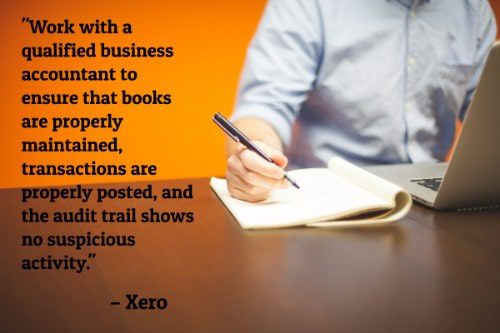
37. Stamp out internal theft with proper inventory asset bookkeeping. “To prevent theft by administrative staff, practice good bookkeeping. Ensure that no single person controls too many parts of any financial transaction. Purchases, payroll, reimbursements and other disbursements should require review and signoff by a senior staff member.
“Perform bank reconciliations and review business credit card statements each month. Work with a qualified business accountant to ensure that books are properly maintained, transactions are properly posted, and the audit trail shows no suspicious activity.” – 10 Tips to Help Clients Prevent Employee Theft, Xero; Twitter: @Xero
38. Incentivize the participation in asset-related training and professional development programs. “Consider offering a program that will pay some, or even all, of a professional development course for your warehouse staff. These incentives are win-win – your employees will be comfortable with change, and the knowledge they gain can drive both quicker implementation and more effective operation.” – Stephen “Stevie” Hay, General Manager of Aptean’s Distribution & Plant Management Group, Helping Warehouse Employees Thrive in an Era of Automation, Aptean; Twitter: @aptean
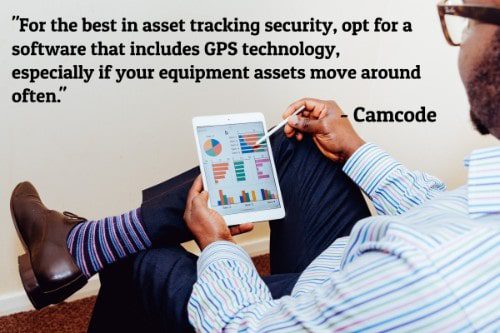
39. Make use of an all-inclusive asset tracking software. “Chances are you’re already ahead of the curve and have invested in asset tracking software of some kind, but just because you have that base covered doesn’t mean that it’s the best option for your business’ assets.
“To ensure that yours is, make sure that the software allows you to input complex, comprehensive information about your assets, including the locations, equipment, and components. In addition to the hierarchy, also guarantee that these specifics can be easily altered in real-time to reflect changes in maintenance schedules, updates on depreciation, and all other relevant info.
“For the best in asset tracking security, opt for a software that includes GPS technology, especially if your equipment assets move around often. Making use of GPS capabilities makes it so that your most high-value assets are always locatable, even if a theft is in progress.” – 4 Best Practices for Oil and Gas Company Asset Management, Camcode; Twitter: @Camcode
40. Be sure that your chosen system includes a comprehensive ‘service desk’ feature. “Well, much as you like to deny it, it is always better to ensure your service desk has an asset management module rather than investing on a stand alone asset management software. Ensuring your asset management software is part of the service desk solution will ensure that data sharing across the organisation is efficient. Additionally, have a service desk solution that has asset management module will ensure a streamlined functioning of all the teams in an organisation.” – Apoorva Ravikrishnan, Product Marketer for Freshservice at Freshworks Inc., 5 Tips for Selecting the Right IT Asset Management Software, Freshservice Blog; Twitter: @freshserviceapp
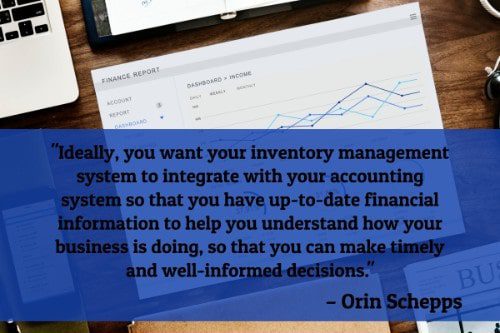
41. Select an asset inventory management system that integrates with your accounting system. “Ideally, you want your inventory management system to integrate with your accounting system so that you have up-to-date financial information to help you understand how your business is doing, so that you can make timely and well-informed decisions. For businesses that already use Intuit’s QuickBooks accounting software, inventory valuations can be tracked in real-time and the financial statements are updated seamlessly for inventory changes.
“Whatever system you decide to use, maintain its effectiveness by conducting regular inventory counts of what you have in stock, and reconcile any differences between your physical inventory account and your inventory records on a timely basis. You should understand why these reconciling differences occur and manage the potential risk of theft.” – Orin Schepps, Seeing Clearly: 3 Tips for Effective Sales Inventory Management , Consultance Accounting; Twitter: @Consultancellc
42. Consider IT asset management in terms of centralization. “In reality, all IT shops should have the means (policies, procedures, tools) to support asset management for the enterprise. The ability to record purchases, costs, contracts, locations and disposal data helps the organization make informed decisions about strategic purchases.
“We’re all for minimizing the incremental risks and related costs associated with IT infrastructure projects that are based on old, incomplete and/or less accurate information. So having a central location of these assets helps in performing important upgrades on versions of equipment and software.” – Norm Brien, IT Asset Management: How to Be Efficient, CIO; Twitter: @CIOonline
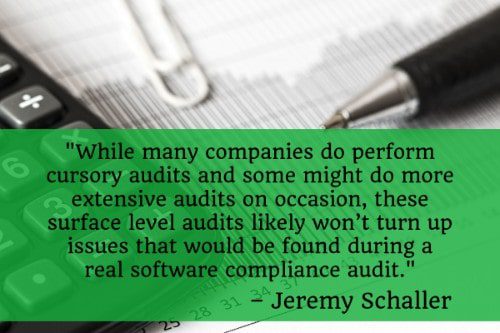
43. Use your IT to prioritize self audits. “Risk is the main cause of uncertainty in any organization. Thus, companies increasingly focus more on identifying risks and managing them before they even affect the business. In the world of IT inventory management, self-auditing processes can help companies be proactive in finding problems before a real audit occurs. Staying on top of audits can also facilitate smoother projects like data center consolidations or decommissions.
“While many companies do perform cursory audits and some might do more extensive audits on occasion, these surface level audits likely won’t turn up issues that would be found during a real software compliance audit.” – Jeremy Schaller, IT Inventory Management: What, Why, and How (Best Practices), exIT Technologies; Twitter: @exittech
44. Take advantage of automated maintenance scheduling for all assets. “Most maintenance management software allows you to keep detailed notes on all aspects of any given asset. Take advantage of this by maintaining maintenance history and costs. This can serve as a comparison point for the future, or as a way to gauge if a certain model is reliable once replacement becomes necessary. Similarly, maintaining the calibration events and troubleshooting results for an asset will prove useful across multiple locations and for multiple assets.” – 7 Tips for Better Asset Management with Maintenance Management Software, DPSI; Twitter: @dpsiCMMS
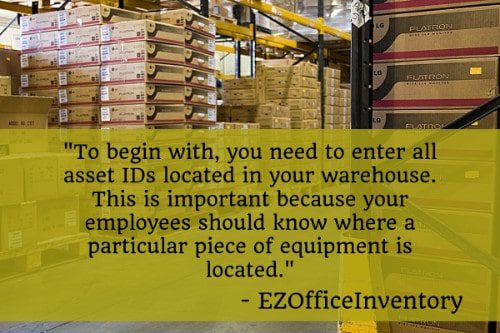
45. Use tried and true asset tag technology to keep track of your assets. “As your business grows, it is bound to acquire a large asset base. With all these additional tools and machines, inventory control is bound to get tough. The easy way out would be to devise a tracking system which makes inventory processes much more streamlined. To begin with, you need to enter all asset IDs located in your warehouse. This is important because your employees should know where a particular piece of equipment is located. Instant data on assets help staff workers carry out their daily tasks much more efficiently!
“With special features included in asset inventory software, you can create barcodes for all your office items. Barcode and QR labels allow you to quickly scan and enter all relevant information in your systems. For example, you can save the warehouse location of asset X at a particular time. Asset tags also let you track inventory movements every time an employee checks out an asset. Monitor business activities with easily accessible information to increase asset optimization.” – The 5 Rules to Simplify Asset Management with Asset Inventory Software, EZOfficeInventory; Twitter: @officeinventory
46. Implement the best system support possible. “Including exception reporting, inventory on hand and on-order availability by location, as well as projection of how SKUs are selling vs. when purchase orders need to be placed to prevent stocks-outs. This also includes having the ability to reserve a SKU quantity to a customer order, and vendor management to monitor and track vendor-shipped orders.” – Curt Barry, Founder & Chairman of F. Curtis Barry & Company, 10 Tips for Improving Your Inventory Management, Multichannel Merchant; Twitter: @mcmerchant
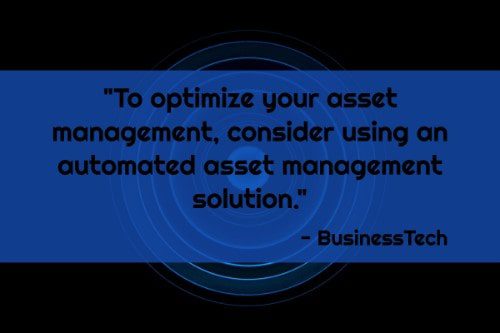
47. Rely on cutting-edge automation. “Managing assets manually takes a lot of time, effort, and costs without getting the equivalent results. To optimize your asset management, consider using an automated asset management solution. This software automates your asset management processes, such as asset value and depreciation tracking, asset maintenance, contract management, cost analysis, and in-depth report generation. By automating complex asset management tasks, you will be able to improve the efficiency, effectiveness and productivity of your business.” – 5 Effective Asset Management Tips for Improving Business Efficiency, BusinessTech; Twitter: @HashMicro
48. Use your company’s IT data to make big picture predictions. “Understand that in today’s economic climate, cash is king. If you are sitting in a good position, make cutbacks to your spending but invest in tools and people that will help you in the long run to grow your business and drive greater efficiency. With layoffs and companies eager to keep sales high, you can secure some top quality talent and excellent deals on the technology tools you need.” – Bill Harrison, President of Demand Solutions, Top Five Tips to Rescue Your Business with Inventory Management, All Business; Twitter: @AllBusiness_com

49. Ensure that you IT inventory asset management systems come equipped with easy integration tools. “The IT Asset Management application should be easy to integrate with other applications. Imagine spending hours just to integrate the IT Asset Management application with the helpdesk application that your company uses. It will be just sheer waste of time and hard work, and now imagine what will happen if your company decides to move to a different ticketing software. It will be a double whammy. Now, you will have to spend time to learn the new helpdesk application and at the same time you will have to ask an expert to spend a considerable amount of time to figure it out how to integrate the existing IT asset management application with the new helpdesk application that you have just purchased.” – Vaishali Gopi, Important Tips to Consider in Buying IT Asset Management Software, Maintworld; Twitter: @maintworld
50. Integrate all ERP data with an asset-based management software. “Companies should consider integrating their enterprise resource planning solution with inventory management software. Implementing mobile data collection technologies into the warehouse will help keep employees and managers on top of inventory and help them to see where and what they have on their shelves, allowing for easier picking and delivery.” – Dustin Caudell, 5 Tips for Successful Inventory Management, RFgen; Twitter: @RFgenSoftware
Our sales engineers are experts in automatic asset tracking, tagging and identification,a nd can answer all your questions. Get in touch now.
Lets Talk ›Enter your information and get a free checklist of the top questions to answer and tips to plan a successful asset tagging project for any asset management or tracking system implementation.